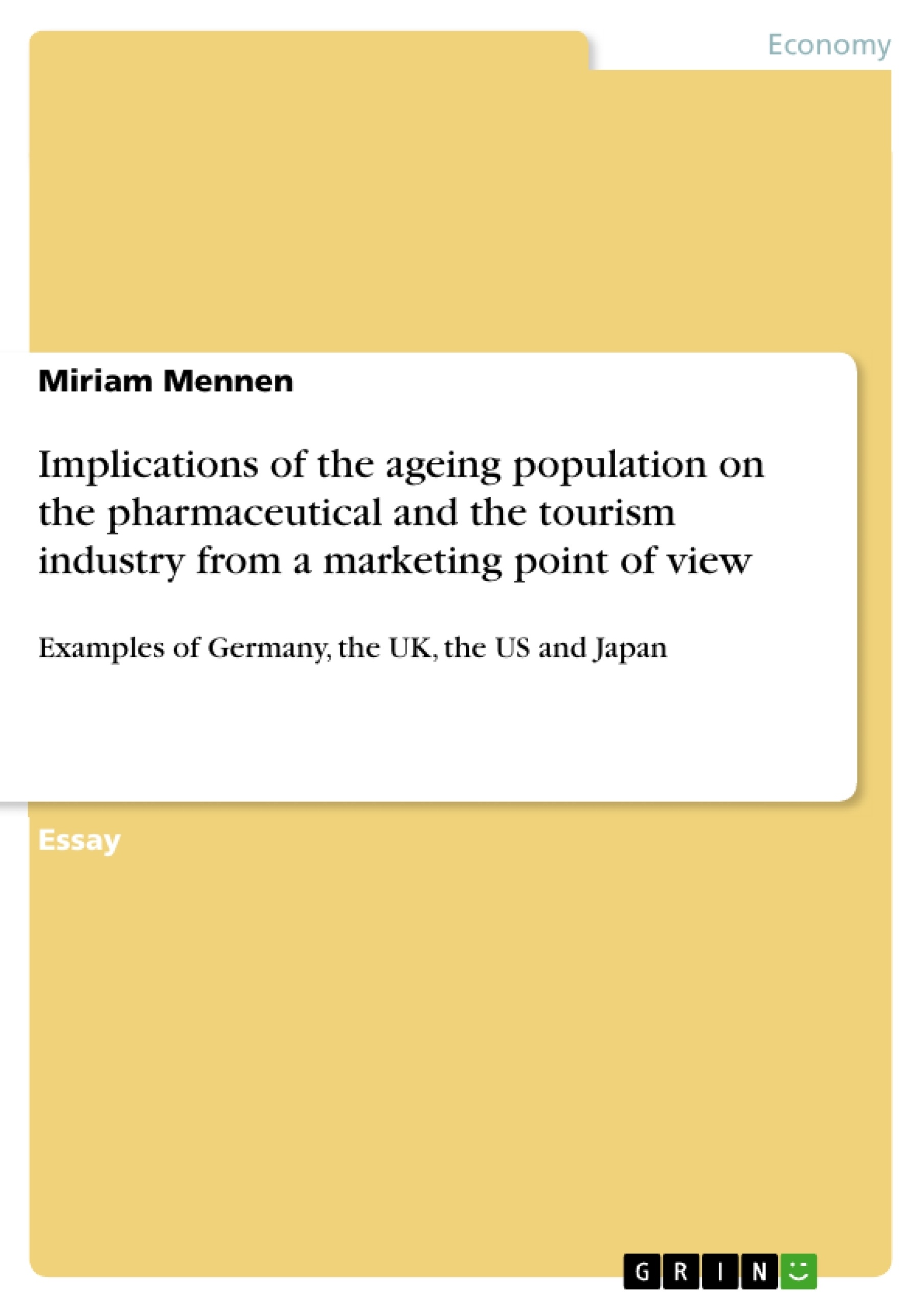Due to the world’s demographic development towards an increasing aging population, various richer economies experience major changes influencing the specific industries. This report will illustrate the implications of these changes, with particular reference to the population over the age of 65, on the pharmaceutical and the tourism industry from a marketing point of view. Examples will be drawn from the US, the UK, Germany and Japan as they are highly affected by the changing demographics.
The main purpose of the report is among others to outline significant impacts on the micro and macro environment, relating to the mentioned industries. Furthermore, the implications on the particular marketing strategies will be evaluated in order to solve potential problems with their implementation. Finally, recommendations will be given on how to overcome these problems and difficulties.
Inhaltsverzeichnis (Table of Contents)
- Introduction
- The US
- The UK
- Germany
- Japan
- The Tourism Industry
- The Pharmaceutical Industry
- Micro and Macro Environment
Zielsetzung und Themenschwerpunkte (Objectives and Key Themes)
This report explores the impact of the aging population on the pharmaceutical and tourism industries. It examines the implications of this demographic shift on both the macro and micro environments of these industries. Additionally, the report analyzes the effects on marketing strategies and suggests solutions to overcome potential challenges.
- Impact of demographic changes on the pharmaceutical and tourism industries
- Analysis of the macro and micro environment influences
- Evaluation of the effects on marketing strategies
- Recommendations for overcoming challenges and difficulties
- Examples from the US, UK, Germany, and Japan
Zusammenfassung der Kapitel (Chapter Summaries)
- Introduction: This chapter introduces the concept of the aging population and its global significance. It highlights the increasing proportion of elderly individuals in various economies, particularly those over 65 years old. This demographic shift is presented as a historical phenomenon with specific geographical variations.
- The US: This chapter explores the impact of the aging population on the US economy. It highlights the growing size and influence of the senior population, particularly in terms of their spending power and economic contribution. The chapter provides statistical data and projections about the future growth of the elderly population in the US.
- The UK: This chapter discusses the demographic changes occurring in the UK and their impact on the country's population structure. It highlights the increasing proportion of individuals aged 60 and above and outlines projected trends for the future. The chapter presents data on the age distribution within the UK population and its implications.
- Germany: This chapter examines the aging population in Germany, highlighting the significant increase in life expectancy over the past few decades. It explores the factors contributing to this demographic shift, including improved medical treatments and changes in working conditions. The chapter also presents data on the age distribution of the German population and its future projections.
- Japan: This chapter explores the demographic characteristics of Japan, highlighting the country's status as an aging nation with a declining population. It provides data on the proportion of elderly individuals in Japan and their economic influence.
- The Tourism Industry: This chapter discusses the dynamic nature of the tourism industry and its susceptibility to external factors. It highlights the significant impact of demographic shifts on travel and tourism demand, particularly the growing influence of the aging population.
- The Pharmaceutical Industry: This chapter examines the increasing demand for pharmaceuticals in developed economies due to the aging population. It highlights the dynamic and profitable nature of the pharmaceutical industry and the role of major multinational companies in shaping the global drug market.
- Micro and Macro Environment: This chapter explores the impact of the aging population on both the micro and macro environments of the pharmaceutical and tourism industries. It utilizes the PEST analysis to examine the macro environment and discusses the influence of demographic changes on factors such as competitors, customers, and suppliers within the micro environment.
Schlüsselwörter (Keywords)
This report focuses on the impact of the aging population on the pharmaceutical and tourism industries. Key themes include demographic changes, macro and micro environment analysis, marketing strategies, and solutions to overcome challenges. The report utilizes examples from the US, UK, Germany, and Japan to illustrate the effects of this demographic shift on various economies.
- Citation du texte
- Miriam Mennen (Auteur), 2007, Implications of the ageing population on the pharmaceutical and the tourism industry from a marketing point of view , Munich, GRIN Verlag, https://www.grin.com/document/145656



